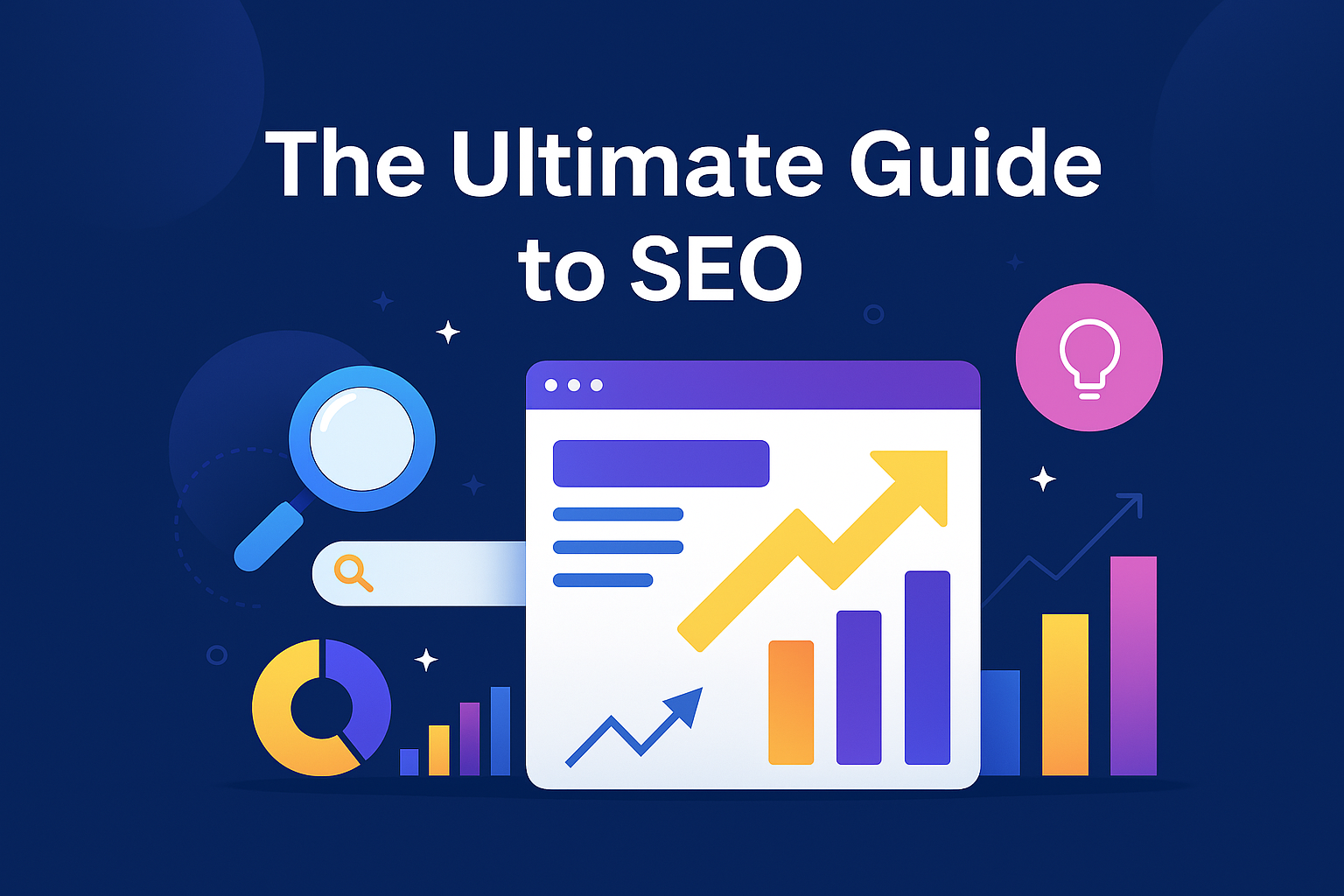Introduction
In today’s digital world, Search Engine Optimization (SEO) is essential for businesses looking to grow online. With over 5.6 billion searches on Google per day, ranking on the first page is crucial for visibility and success.
This guide will cover everything about SEO, from its fundamentals to advanced strategies, ensuring that your website attracts organic traffic and ranks higher on search engines.
What is SEO?
SEO (Search Engine Optimization) is the process of optimizing a website to improve its visibility on search engines like Google, Bing, and Yahoo. The goal is to appear on the first page of search results, increasing traffic and potential conversions.
Why is SEO Important?
- 75% of users never scroll past the first page of search results.
- Organic search drives 53% of website traffic.
- SEO provides long-term benefits compared to paid ads.
🖼 Image Idea: A graph showing organic traffic growth from SEO efforts.
Types of SEO
SEO is divided into three main categories:
1. On-Page SEO
This involves optimizing elements within your website:
- Keyword research & optimization
- Meta titles and descriptions
- Header tags (H1, H2, H3)
- Image optimization (alt text, file size reduction)
- Internal linking strategy
2. Off-Page SEO
Activities outside your website that boost its credibility:
- Link building (backlinks from high-authority sites)
- Guest blogging
- Social media engagement
- Influencer outreach
3. Technical SEO
Optimizing your site’s backend structure:
- Mobile-friendliness
- Site speed optimization
- Secure website (HTTPS)
- XML sitemaps & robots.txt configuration
- Structured data (Schema Markup)
🖼 Image Idea: A diagram illustrating the three types of SEO.
Keyword Research: Finding the Right Keywords
Choosing the right keywords is the foundation of successful SEO.
How to Find the Best Keywords?
Use tools like:
- Google Keyword Planner
- SEMrush
- Ahrefs
- Ubersuggest
Types of Keywords:
- Short-tail keywords (e.g., “digital marketing”) – High competition
- Long-tail keywords (e.g., “best digital marketing strategies for startups”) – Low competition, high conversion
- LSI keywords (related terms Google associates with the main keyword)
🖼 Image Idea: Screenshot of a keyword research tool with keyword suggestions.
On-Page SEO Strategies
1. Optimizing Title Tags & Meta Descriptions
Your title tag is the first thing users see on search results. ✅ Keep it under 60 characters. ✅ Include your primary keyword. ✅ Make it engaging and click-worthy.
Example: “The Ultimate SEO Guide: Rank #1 on Google in 2024”
2. URL Optimization
Your URLs should be short, descriptive, and keyword-rich. ❌ Bad URL: www.example.com/p=123 ✅ Good URL: www.example.com/seo-guide-2024
3. Internal & External Linking
- Internal links connect pages on your website, helping with navigation.
- External links (outbound links) boost credibility when linking to authoritative sources.
🖼 Image Idea: A diagram showing internal and external linking structure.
Technical SEO Checklist
1. Mobile Optimization
With over 60% of searches coming from mobile, ensure:
- Responsive design
- Fast-loading mobile pages
- Easy navigation on smaller screens
2. Website Speed Optimization
40% of users leave a website if it takes more than 3 seconds to load!
🚀 Ways to Improve Speed:
- Use Google PageSpeed Insights to analyze speed.
- Compress images using TinyPNG.
- Minimize CSS, JavaScript & HTML using Gzip compression.
3. Secure Your Website (HTTPS)
A secure website builds trust. Always use SSL certificates.
🖼 Image Idea: A speed test comparison between a fast and slow website.
Off-Page SEO Strategies
1. Link Building Strategies
Backlinks from high-authority websites boost rankings. ✅ Guest blogging ✅ Broken link building ✅ HARO (Help A Reporter Out)
2. Social Media & Brand Mentions
Social signals (likes, shares, mentions) indirectly help SEO. ✅ Share content on Facebook, LinkedIn, Twitter ✅ Engage in relevant discussions
🖼 Image Idea: Infographic showing how backlinks improve search rankings.
Local SEO: Get Found in Your Area
For businesses targeting local customers, Local SEO is crucial. ✅ Google My Business listing ✅ Local citations on directories (Yelp, Justdial, IndiaMart) ✅ Encourage customer reviews
🖼 Image Idea: A screenshot of a Google My Business profile.
Content Marketing & SEO
Content is King! Search engines prioritize high-quality, relevant content.
1. Blog Posts
✅ Solve user problems ✅ Use proper headings & structure ✅ Add visuals, infographics, videos
2. Video Content for SEO
YouTube is the 2nd largest search engine. Optimize videos by: ✅ Using relevant titles & descriptions ✅ Adding subtitles & timestamps ✅ Embedding videos on your website
🖼 Image Idea: A visual representation of different content types (blogs, videos, infographics).
SEO Trends for 2024
1. AI & SEO
Google’s AI-powered updates (like BERT & RankBrain) now focus more on user intent rather than just keywords.
2. Voice Search Optimization
By 2025, 50% of all searches will be voice-based. ✅ Use conversational, long-tail keywords. ✅ Structure content in Q&A format.
3. Core Web Vitals
Google now prioritizes User Experience (UX). ✅ Faster page load speed ✅ Mobile usability ✅ Low bounce rates
🖼 Image Idea: Graph showing increasing voice search usage.
SEO Tools You Should Use
Here are some essential SEO tools:
- Google Search Console – Monitor performance
- SEMrush – Keyword & competitor analysis
- Ahrefs – Backlink research
- Yoast SEO – Optimize WordPress SEO
- Moz – Rank tracking & site audits
🖼 Image Idea: Screenshot of an SEO tool dashboard.
Conclusion
SEO is a long-term strategy, but the rewards are worth it. By focusing on keyword research, high-quality content, and technical optimizations, you can drive massive organic traffic.
🚀 Ready to rank higher on Google? Let’s start optimizing today!
📩 Need help with SEO? Contact us at [YourWebsite.com]





3 Comments
This is exactly what i was looking for, thank you so much for these tutorials
It would be great to try this theme for my businesses
What a nice article. It keeps me reading more and more!